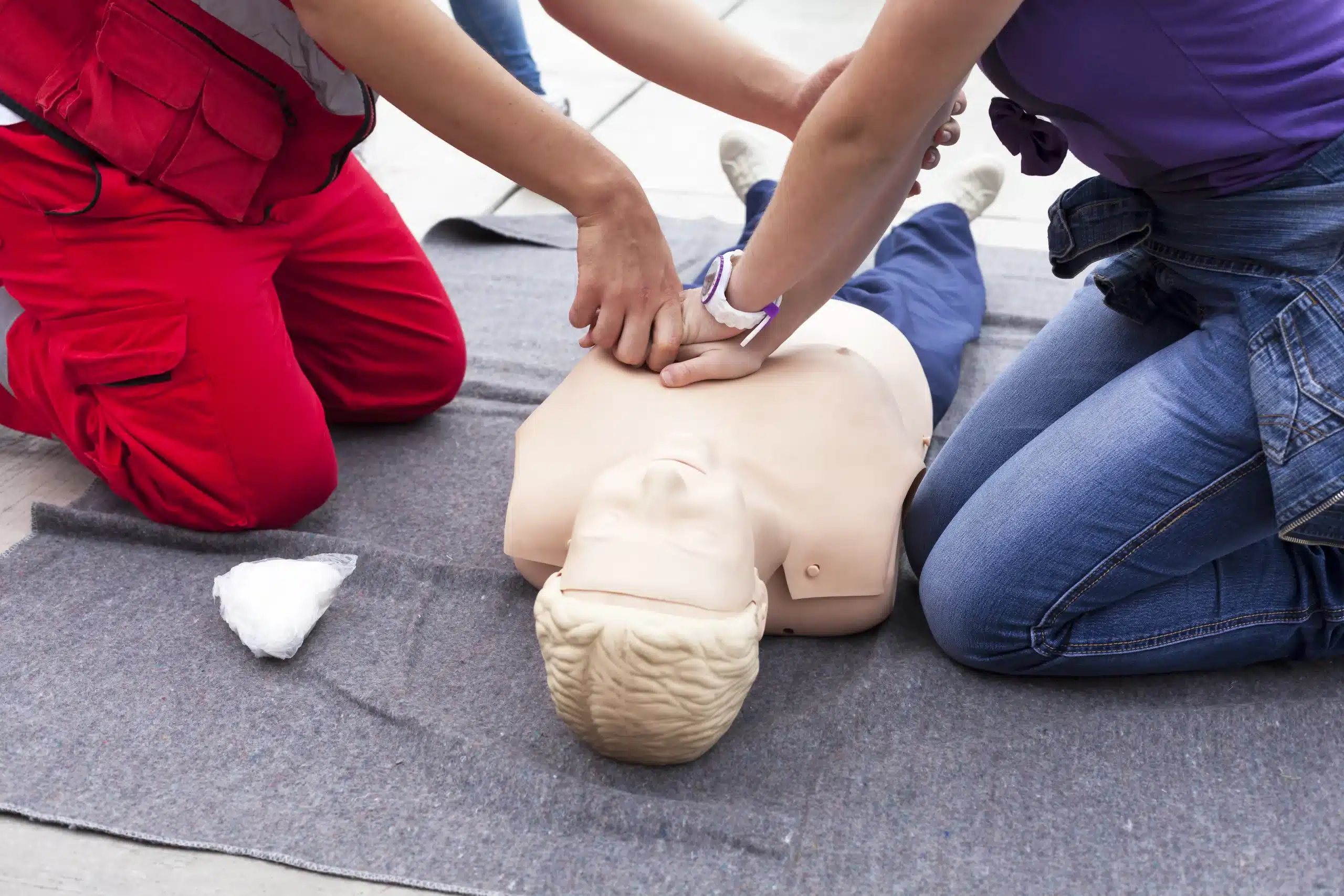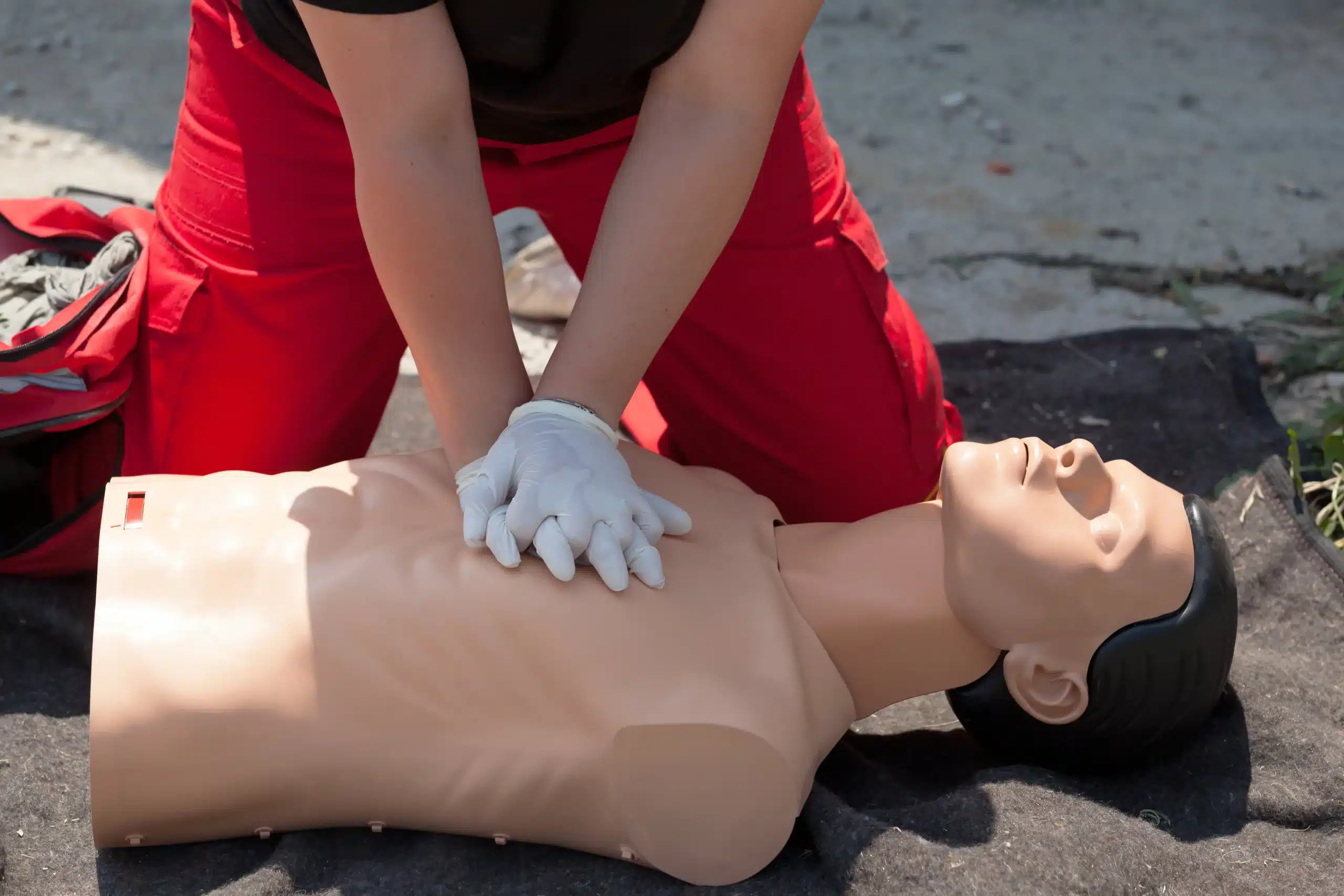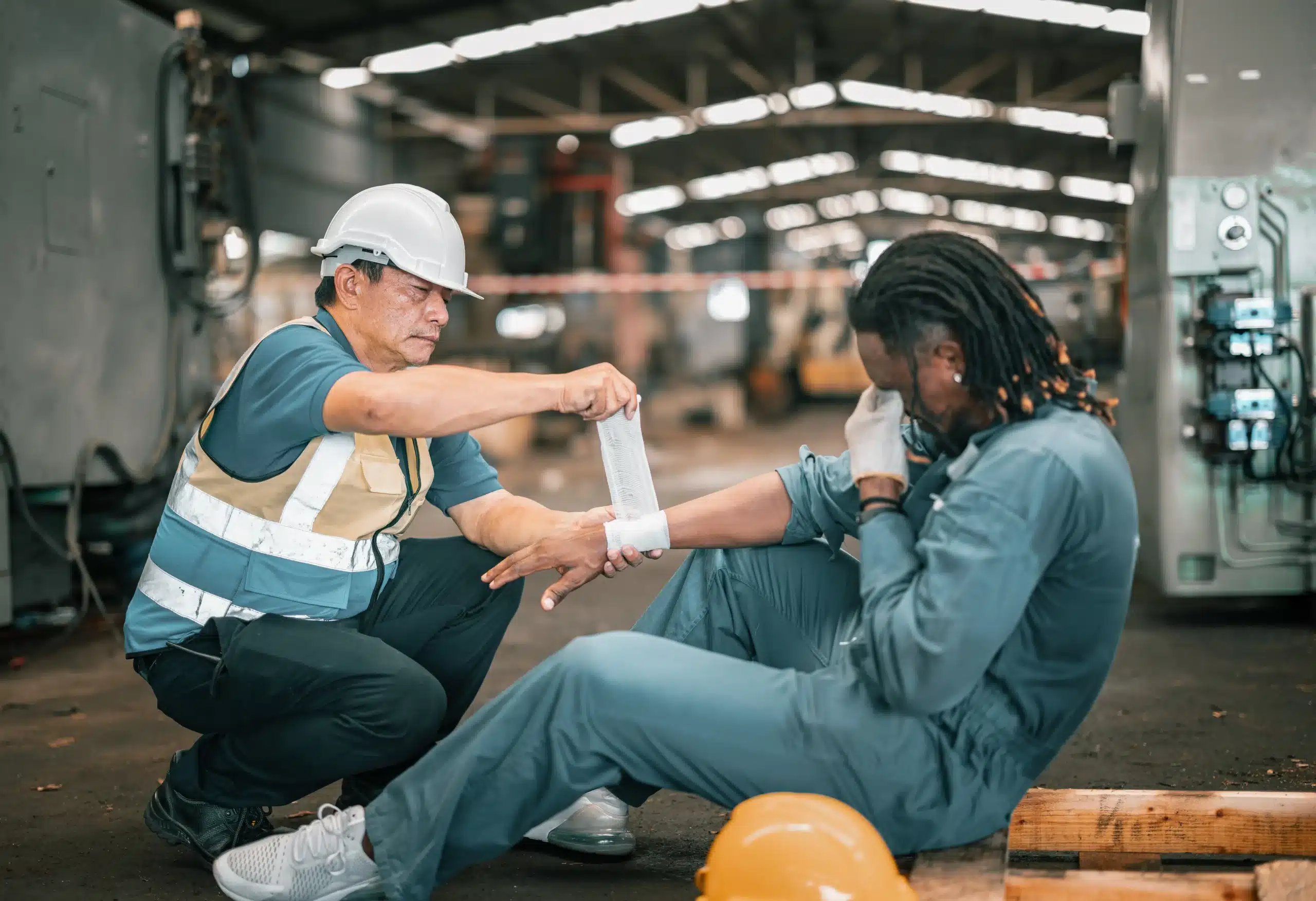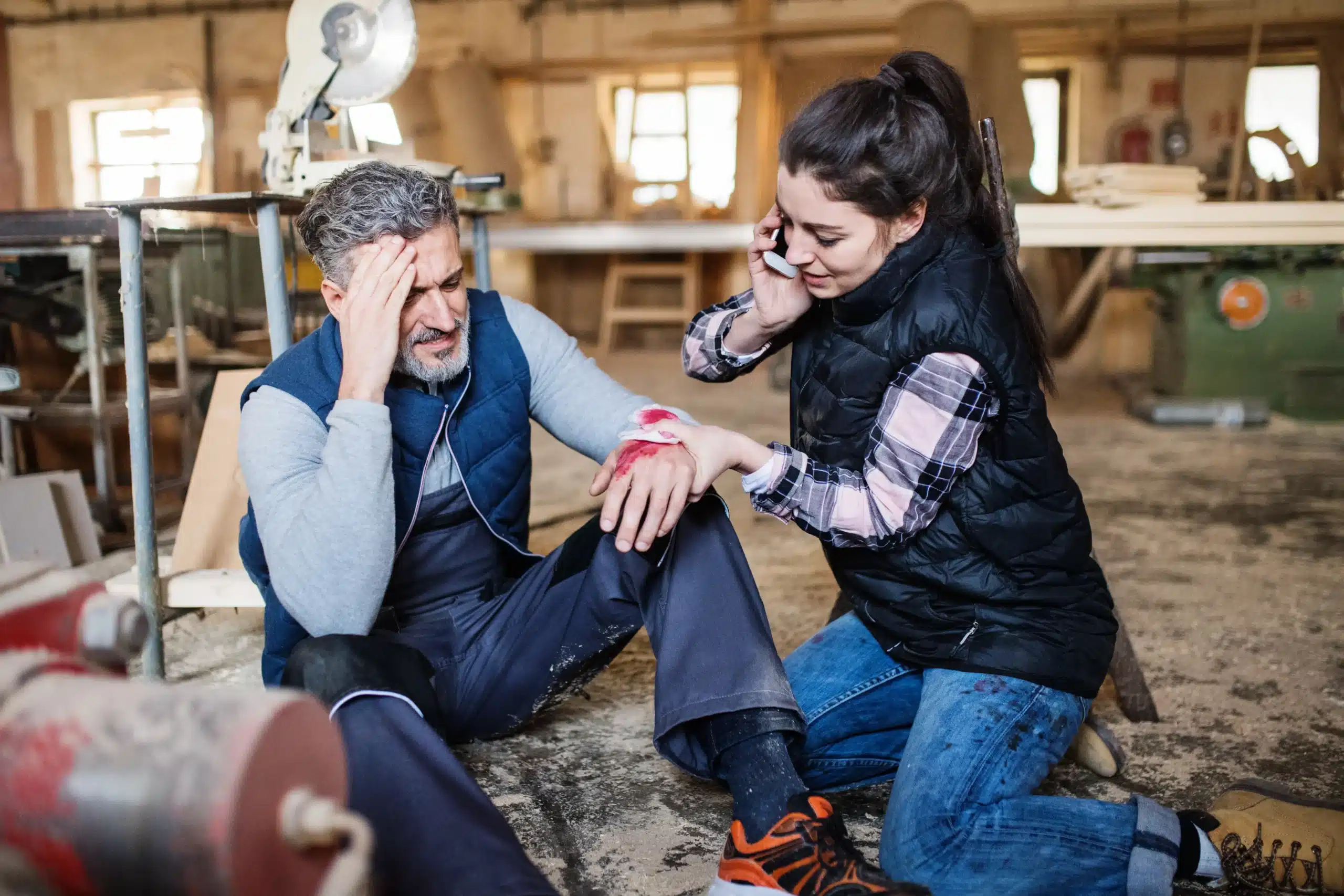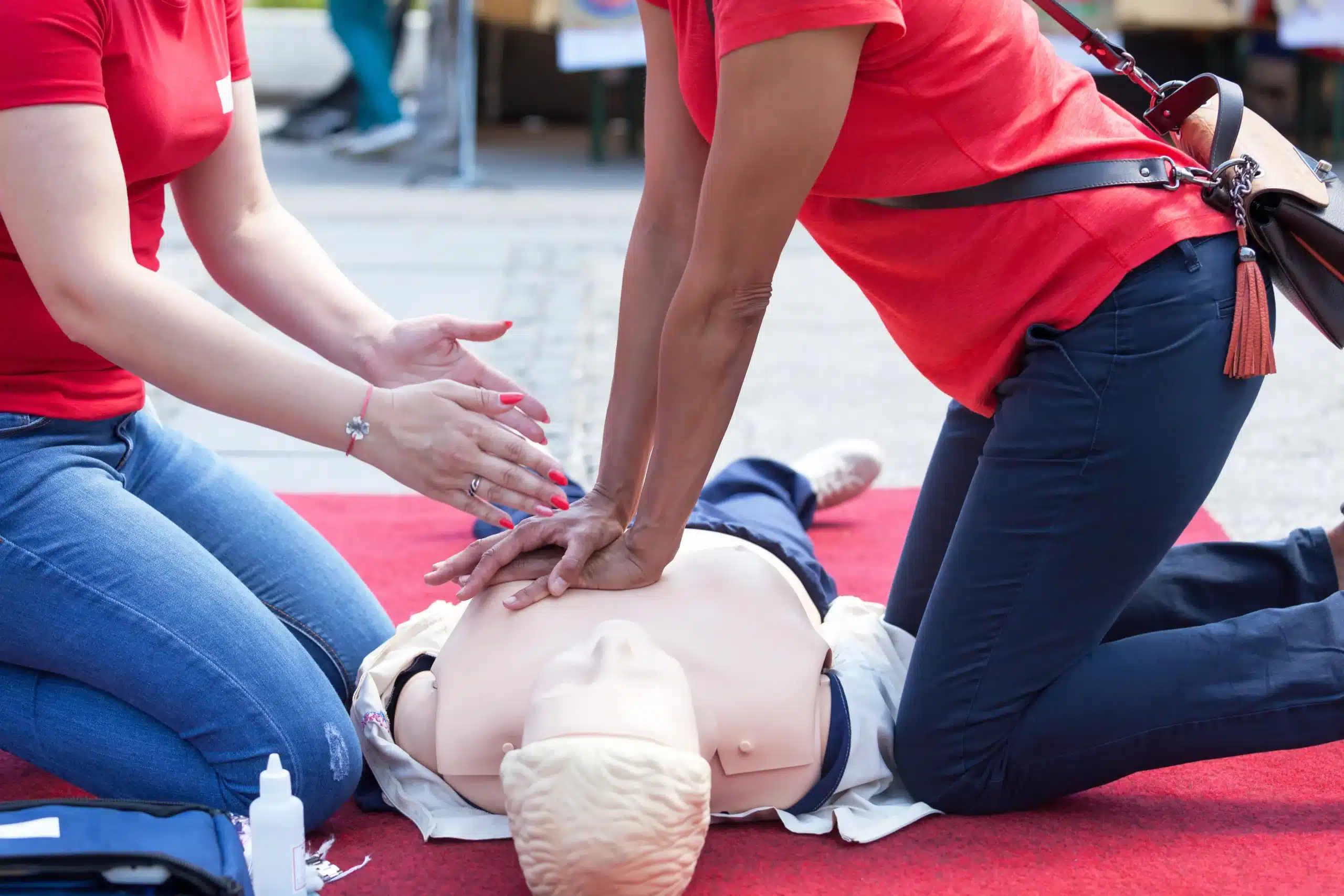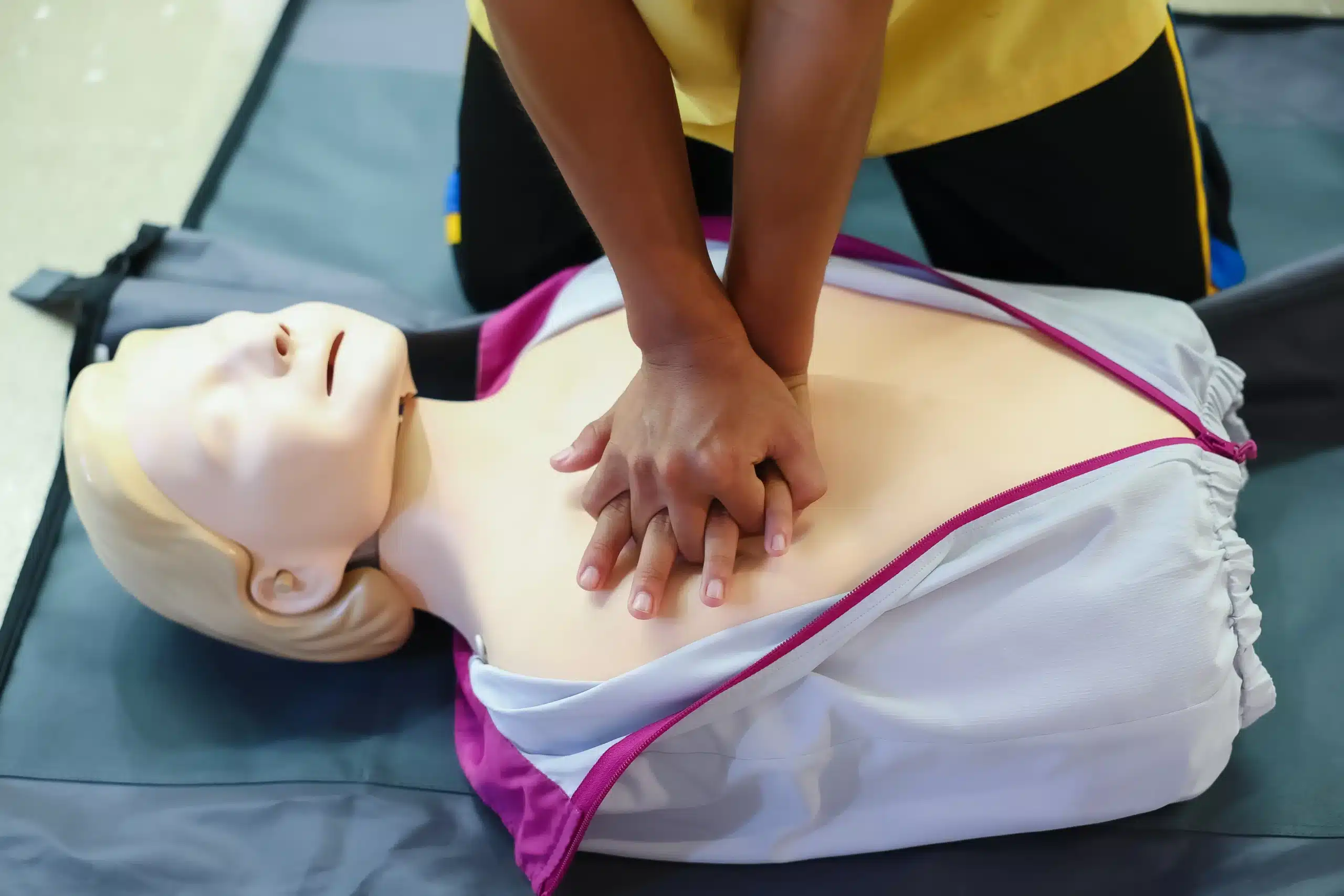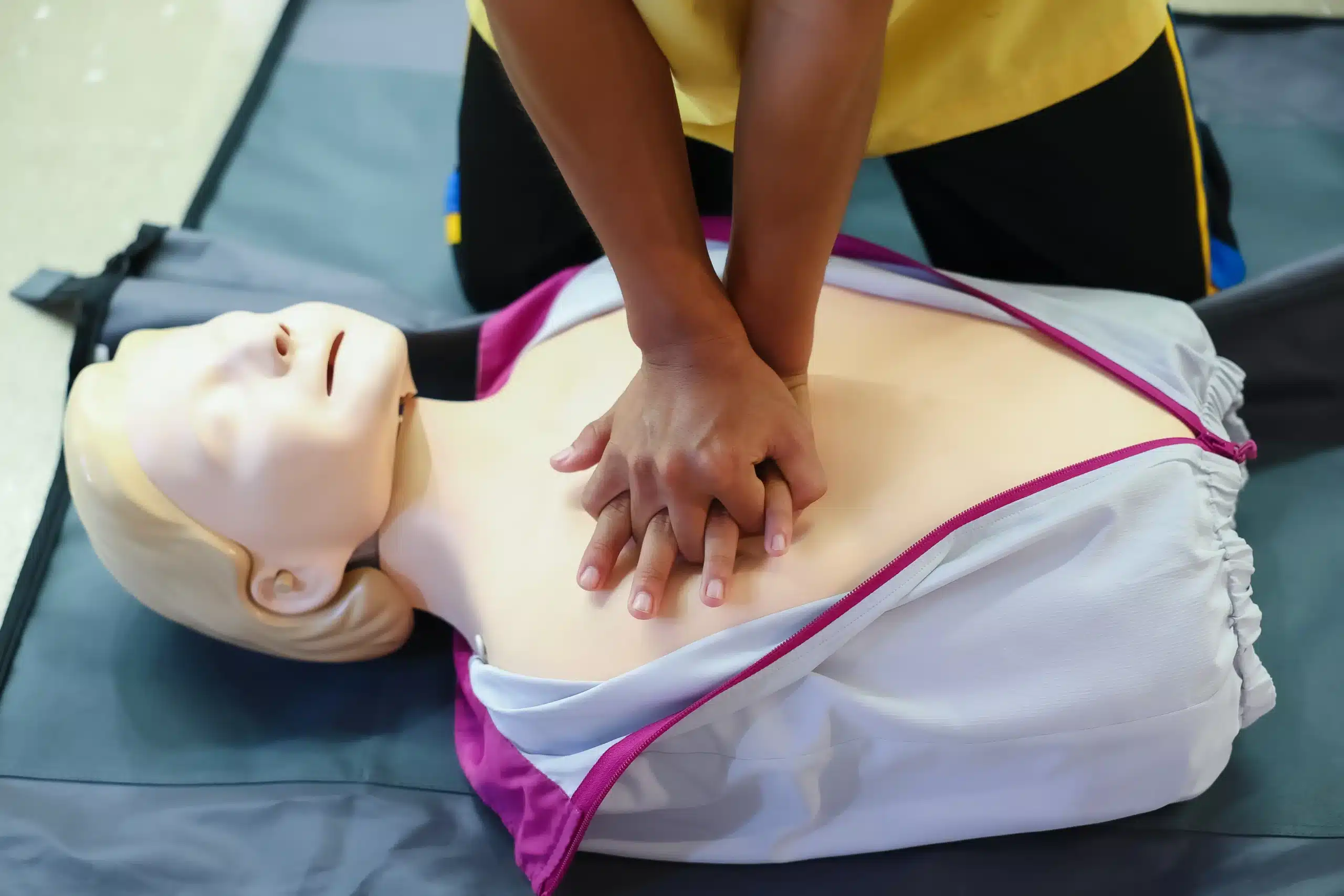Empowering yourself with life-saving skills starts with finding the right CPR training. With numerous CPR classes in San Jose, it can be challenging to know where to begin. This guide simplifies the process, providing a clear overview of CPR training options in San Jose, including different certification levels, course formats, and leading training providers. Whether you’re looking for basic CPR certification or advanced training for healthcare professionals, we’ll help you navigate the choices and find the perfect CPR class in San Jose to meet your specific needs and goals.
Key Takeaways
- CPR skills empower you to save lives: Whether you’re a healthcare professional or a concerned community member, learning CPR equips you to respond effectively in emergencies. Explore the various CPR certifications available, from basic life support to advanced cardiovascular life support, and find the right fit for your needs.
- Finding the right CPR class involves research: Consider factors like the training format (in-person, online, or blended), instructor experience, and the provider’s reputation. Look for training centers that prioritize hands-on practice and offer continuing education opportunities.
- Maintaining your CPR skills is an ongoing commitment: CPR guidelines and best practices are regularly updated. Stay current with the latest recommendations by renewing your certification every two years and seeking out additional resources like the RQI program to refine your technique.
What is CPR and Why is it Important?
CPR, or cardiopulmonary resuscitation, is a lifesaving technique used when someone’s heart stops beating. It combines chest compressions and rescue breaths to circulate oxygenated blood to the brain and other vital organs. Learning CPR empowers you to respond effectively during cardiac arrest emergencies, potentially bridging the gap until professional medical help arrives. This immediate action can significantly improve the chances of survival and minimize long-term complications. Effective CPR training is crucial for building confidence and competence in these critical situations. For residents of San Jose, Santa Clara, and Sunnyvale, CPR certification courses are readily available.
Common CPR Training Misconceptions
One common misconception is that online CPR training is just as effective as in-person training. While online courses offer convenience, they often lack the hands-on practice and personalized feedback crucial for mastering proper CPR techniques. On-site training allows for real-time feedback from instructors, ensuring you develop the correct skills and confidence to perform CPR effectively. Another misconception is that CPR certification lasts forever. In reality, CPR guidelines and best practices are regularly updated, making refresher courses essential for maintaining up-to-date knowledge and skills. Check with your certifying organization for renewal requirements.
Benefits of CPR Training
Learning CPR offers a range of benefits, extending beyond the ability to respond to emergencies. It equips you with valuable skills and knowledge that can make a real difference in someone’s life. The confidence gained through training empowers you to act quickly and decisively in stressful situations. Furthermore, CPR training fosters a sense of preparedness and community responsibility, encouraging individuals to be active bystanders rather than passive observers. Improving CPR training is a continuous process, and programs like the American Heart Association’s RQI program utilize real-time feedback and distributed practice to enhance the quality of CPR performance. This commitment to ongoing improvement ensures that individuals are equipped with the most effective techniques to provide lifesaving assistance.
CPR Classes in San Jose: What are Your Options?
Finding the right CPR class can feel overwhelming with so many choices. This section breaks down the different types of CPR training available in San Jose, so you can choose the best fit for your needs.
Basic CPR
Basic CPR classes are perfect for anyone wanting to learn essential lifesaving skills. These courses cover adult, child, and infant CPR, along with how to use an automated external defibrillator (AED) and what to do if someone is choking. Many workplaces require this level of training, and it’s a valuable skill for parents, teachers, and community members. The American Red Cross offers these classes throughout San Jose. You’ll also find basic CPR training through community centers and other local organizations. Upon completion, you’ll receive a certification valid for two years.
BLS for Healthcare Providers
Healthcare providers, like doctors, nurses, and paramedics, need a more advanced skillset. BLS (Basic Life Support) certification goes beyond basic CPR to include team dynamics, high-quality chest compressions, and advanced airway management. BLS certification is typically required for healthcare professionals and is often a prerequisite for other advanced certifications. Safety Training Seminars offers BLS courses in San Jose and other American Heart Association Training Centers. Like basic CPR certification, BLS certification is also valid for two years. Check with your employer or licensing board to confirm the required certification level. You can learn more about our BLS course on our website.
ACLS for Advanced Medical Professionals
ACLS (Advanced Cardiovascular Life Support) is the next step up from BLS. This course is designed for medical professionals who manage cardiopulmonary arrest and other cardiovascular emergencies. ACLS training covers complex algorithms, pharmacology, and effective team communication during critical situations. It’s essential for physicians, nurses, paramedics, and other healthcare professionals working in emergency rooms, intensive care units, and other critical care settings. Many of the same organizations that offer BLS also provide ACLS training.
Pediatric CPR and First Aid
For those working with children, like teachers, daycare providers, and camp counselors, Pediatric CPR and First Aid training is crucial. These courses focus on the specific needs of infants and children in medical emergencies. You’ll learn how to perform CPR on infants and children, manage common childhood injuries, and recognize signs of illness. In California, teachers are required to have certifications in CPR, AED, and First Aid. Be sure to check the state requirements for educators. You can find Pediatric CPR and First Aid classes through organizations like the American Red Cross and other certified providers. For California childcare providers, consider the EMSA Health, Safety, and Lead Poisoning Prevention course.
CPR Training in San Jose: Formats and Features
CPR training has evolved to meet diverse learning styles and schedules. Let’s explore the various formats and features available in San Jose.
In-Person Classes
In-person CPR classes offer a hands-on learning experience guided by qualified instructors. This format provides immediate feedback and allows for real-time correction of techniques. The dynamic environment of an in-person class can be particularly helpful for those who thrive in interactive settings. For those seeking in-person training, consider checking out the BLS courses offered by Safety Training Seminars in San Jose.
Online Courses
Online CPR courses offer flexibility and convenience. They allow you to learn at your own pace and fit the training around your busy schedule. Online certification courses are also frequently updated, ensuring you learn the most current CPR guidelines. This format often works well for those who prefer self-directed learning or have limited availability.
Blended Learning
Blended learning combines the benefits of online and in-person training. You can cover the theoretical material online and then practice your skills in a hands-on, in-person session. This approach ensures a comprehensive understanding of CPR principles and provides the opportunity to refine your technique with expert guidance.
Real-Time Feedback Technology
Some CPR training programs incorporate real-time feedback technology, such as the American Heart Association’s Resuscitation Quality Improvement (RQI) program. RQI uses specialized manikins that provide immediate feedback on your compressions and breaths, helping you develop accurate and effective CPR skills. This technology enhances the learning process and promotes mastery of essential techniques. For more information, visit our page dedicated to RQI classes.
Peer Videorecording Feedback
Peer videorecording feedback is an innovative approach to CPR training. Studies have shown that reviewing video recordings of your CPR performance with peers can significantly improve skill acquisition and retention. This method allows for detailed analysis of technique and encourages collaborative learning.
CPR Classes in San Jose: How Much Do They Cost?
Knowing the price range for CPR classes helps you budget and find the best value. Several factors influence how much you’ll pay for CPR training in San Jose.
Factors Affecting CPR Class Prices
CPR class costs depend on several factors. The type of certification you need (basic CPR or healthcare provider BLS), the course format (in-person or blended learning), and included materials all play a role. A basic CPR class for the community will typically cost less than a BLS course for healthcare providers. The instructor’s experience level can also influence pricing.
Average Costs
In San Jose, basic CPR classes usually cost between $65 and $90. This price generally includes the training, a two-year certification card, and sometimes a CPR mask or gloves. Advanced courses like ACLS or PALS for healthcare professionals cost more because of the specialized training involved. Certifications are typically valid for two years, so remember to factor in renewal costs.
Additional Fees
Be aware of potential extra fees. Some training centers might have separate charges for course materials, certification cards, or online access. If you’re training with a group, ask about discounts. Many providers, including Safety Training Seminars, offer a low price guarantee, so it’s always a good idea to compare prices. Also, check what payment methods the provider accepts and whether they offer payment plans. You can find BLS courses in San Jose offered by Safety Training Seminars on their website.
What Happens in a CPR Class?
CPR classes blend theory and hands-on practice to equip you with lifesaving skills. Whether you choose an in-person or blended learning format, you’ll find a supportive learning environment designed to build your confidence. Experienced, highly-rated instructors guide you through the material and provide feedback, ensuring you’re fully prepared for real-world scenarios.
Course Structure and Duration
CPR classes typically combine classroom instruction with hands-on practice. You can choose from traditional in-person classes or a blended learning approach that combines online modules with in-person skill sessions. This blended format offers flexibility for busy schedules. Many CPR training centers, like those offering American Heart Association courses, have operated for years and have a wealth of experience in delivering effective training.
CPR Skills You’ll Learn
In a CPR class, you’ll learn essential skills to respond to various emergencies. The curriculum covers adult, child, and infant CPR techniques, including how to assess a situation and deliver chest compressions and rescue breaths. You’ll also learn how to use an automated external defibrillator (AED) and how to help someone who is choking. These comprehensive skills, taught by providers like the Santa Clara County Fire Department, empower you to act quickly and confidently in a crisis. The hands-on training makes learning both fun and effective, ensuring you grasp the practical application of these vital techniques.
Certification
Upon successful completion of a CPR class, you’ll receive a certification valid for two years. This certification demonstrates your proficiency in CPR and is often required for certain jobs or volunteer positions. Renewal courses are readily available, allowing you to maintain your skills and credentials. Staying current with your CPR certification ensures you’re always prepared to provide assistance when needed. Two-year certification is standard across most providers, making it easy to track and renew your qualifications.
Find the Right CPR Class
Choosing the right CPR class can feel overwhelming with so many options available. But by focusing on your needs and doing a little research, you can find the perfect fit.
Assess Your Needs
First, think about why you’re taking a CPR class. Are you required to have certification for your job, or are you learning CPR for personal knowledge? Healthcare providers, for example, have different requirements than someone who wants to be prepared for emergencies at home. Knowing your “why” will help you choose the right type of class and the right level of certification. If you’re unsure, reach out to potential training centers—they’re happy to help you figure out which course aligns with your goals. For CPR courses in San Jose and nearby areas, you can explore options like those offered by Safety Training Seminars.
Compare Providers
Once you know what you need, start comparing different CPR training providers. Look at what each provider offers. Do they use innovative training methods like real-time feedback technology? The American Heart Association’s RQI program, for instance, uses this technology to improve CPR skill retention. You can learn more about the RQI program and its benefits on Safety Training Seminars’ website. Also, consider whether you prefer in-person, online, or blended learning. On-site training offers hands-on practice and immediate feedback from instructors, which can be incredibly valuable. For those who prefer online or blended learning options, exploring various CPR training websites can be helpful. This article discusses the benefits of on-site training.
Check Instructor Qualifications
Finally, don’t forget to check the qualifications of the instructors. Experienced, certified instructors can make a huge difference in how much you learn and how confident you feel performing CPR. Look for instructors who are up-to-date on the latest CPR guidelines and who can provide constructive feedback to help you improve your technique. Articles like this one on real-time visual feedback during CPR training highlight the importance of qualified instruction. A good instructor will not only teach you the steps but also empower you to act quickly and effectively in a real emergency. Further research on the impact of instructor feedback, such as this study on peer videorecording feedback, can offer additional insights into effective training methods.
Top CPR Training Providers in San Jose
Finding the right CPR training provider is crucial for a positive and effective learning experience. Here’s a rundown of some of the leading CPR training providers in San Jose:
Safety Training Seminars
Safety Training Seminars stands out with its commitment to excellent customer service and a low price guarantee. They offer a variety of American Heart Association (AHA) courses, including BLS, ACLS, PALS, and First Aid. With a focus on convenience, they provide daily classes in San Jose and surrounding areas like Santa Clara and Sunnyvale. They also offer specialized courses such as the RQI program for healthcare professionals and EMSA Health and Safety training for childcare providers.
American Red Cross
The American Red Cross is a well-known provider of CPR and First Aid training. Their San Jose location offers courses taught by certified instructors, ensuring OSHA compliance, an important factor for workplace safety. Red Cross certification is typically valid for two years.
American Heart Association Training Centers
Several authorized American Heart Association Training Centers operate throughout San Jose and the Bay Area. These centers offer a comprehensive range of AHA courses, including CPR, BLS, ACLS, and PALS. This can be a good option if you need a specific AHA certification.
Santa Clara County Fire Department
The Santa Clara County Fire Department (SCCFD) provides various CPR and AED training courses to the community. They offer basic Hands-Only CPR/AED training and more comprehensive options. Learning CPR directly from first responders can provide a valuable perspective.
Local Hospitals and Community Centers
Many local hospitals and community centers in San Jose offer CPR training. These classes can be a convenient and affordable option, though course schedules and availability vary. Contact your local hospital or community center directly to learn about their offerings.
Prepare for Your CPR Class
Getting ready for your CPR class isn’t just about showing up; it’s about setting yourself up for a truly effective learning experience. A little preparation beforehand can make a big difference in how much you absorb and how confident you feel performing these life-saving skills.
What to Bring
When you head to your CPR class, having the right materials can help you stay organized and engaged. Bring a notebook and pen to jot down key points, questions for the instructor, and any reflections you have during the training. Comfortable clothing is also a must, as you’ll be practicing physical techniques. Since CPR training often involves hands-on practice, having a small towel and a water bottle can also add to your comfort. Remember, on-site training, like what we offer at Safety Training Seminars, provides that immediate feedback from experienced instructors that’s so crucial for mastering CPR. This direct interaction is one of the biggest benefits of in-person training.
Pre-Course Study Materials
While not always required, reviewing some pre-course materials can significantly enhance your understanding and retention of CPR techniques. Think of it as priming your brain for the information to come. Effective CPR training is essential for ensuring you’re prepared to respond confidently in emergencies, and pre-study can play a big role in that. Improving your CPR training is an ongoing process, and familiarizing yourself with the latest guidelines beforehand is a great first step. Many organizations, including the American Heart Association, offer resources like videos and quick guides that can give you a head start. Even something as simple as watching a video demonstrating proper CPR technique can make a real difference in your comfort level during the hands-on portion of the class. Studies have shown that visual aids and feedback can greatly improve CPR quality, so take advantage of any resources available to you.
Maintain Your CPR Certification
CPR certification isn’t a one-and-done deal. Staying current with the latest guidelines and renewing your certification ensures you’re always prepared to provide effective, potentially life-saving assistance.
Renew Your Certification
CPR certifications are typically valid for two years. Think of it like a driver’s license—it needs to be renewed to remain valid. Renewal courses are readily available for those whose certifications are nearing their expiration date. Don’t let your skills lapse; sign up for a renewal course and stay prepared. At Safety Training Seminars, we offer streamlined renewal courses to make the process quick and easy.
Stay Updated on CPR Guidelines
CPR techniques and best practices evolve with ongoing research and medical advancements. Staying informed about these changes is crucial for providing the most effective care. Regularly review updated CPR guidelines and consider incorporating new knowledge into your practice. For example, the American Heart Association has introduced the Resuscitation Quality Improvement (RQI) program, a valuable resource for healthcare professionals seeking to refine their CPR skills. This program emphasizes distributed practice and real-time feedback, enhancing the quality of CPR performance. Staying current with programs like RQI demonstrates a commitment to providing the highest standard of care.
CPR Training in San Jose: What Makes it Unique?
San Jose’s diverse community and focus on public health create a unique environment for CPR training. Several factors contribute to the distinct advantages of learning CPR in this area.
Bilingual Instruction
San Jose recognizes the importance of accessible training. Many CPR classes offer bilingual instruction, catering to Spanish and Vietnamese speakers. This inclusivity removes language barriers and empowers a wider range of people to develop these essential life-saving skills.
Industry-Specific Training
CPR training in San Jose goes beyond the basics. Providers understand that different professions have unique needs. BLS certification covers core skills like CPR, AED use, and airway management. Training programs often tailor their curriculum for specific industries like healthcare, construction, and childcare. This specialized approach ensures professionals develop the targeted skills they need for emergencies in their field. For example, healthcare providers can find BLS courses in San Jose designed specifically for their work. Specialized programs like EMSA Health, Safety, and Lead Poisoning training are also available for childcare providers in California.
Community Programs
San Jose fosters a strong sense of community engagement around CPR training. Organizations like the Santa Clara County Fire Department offer various CPR and AED training programs to residents. These community-focused initiatives build a culture of preparedness and empower individuals to respond effectively during emergencies. The American Heart Association’s RQI program is another valuable resource for healthcare professionals looking to maintain their resuscitation skills. Safety Training Seminars also offers a low price guarantee, making these vital skills accessible to all.
Related Articles
- 12 Common CPR Myths Debunked – San Jose CPR Classes
- Why CPR is Crucial in Saving Lives
- CPR Certification San Jose: Your Complete Guide – San Jose CPR Classes
- CPR Training in Sunnyvale: Your Certification Guide – San Jose CPR Classes
- The History of CPR Training: A Lifesaving Evolution – San Jose CPR Classes
Frequently Asked Questions
How often do I need to renew my CPR certification? CPR certifications typically expire after two years. It’s important to renew your certification before it expires to maintain your skills and credentials. Check with your employer or certifying organization for specific renewal requirements.
What’s the difference between CPR and First Aid certification? CPR focuses on life-saving techniques for someone whose heart has stopped or who isn’t breathing. First Aid covers a broader range of injuries and illnesses, from minor cuts and burns to more serious situations like broken bones or allergic reactions. Some courses combine both CPR and First Aid training.
Is online CPR training sufficient, or do I need an in-person class? While online CPR training offers flexibility and convenience for learning the basics, in-person classes provide crucial hands-on practice and personalized feedback from certified instructors. This hands-on experience is essential for developing the confidence and skills to perform CPR effectively in a real-life emergency.
What if I’m not sure which type of CPR class is right for me? If you’re unsure which CPR class aligns with your needs, reach out to a training provider. They can help you determine the appropriate level of certification based on your profession, personal goals, or any specific requirements you may have. Don’t hesitate to ask questions – they’re there to guide you.
Are there CPR classes offered in languages other than English? Yes, many CPR training providers in San Jose offer bilingual classes, often in Spanish and Vietnamese. When searching for a class, check with the provider about language options to find a course that meets your needs.


